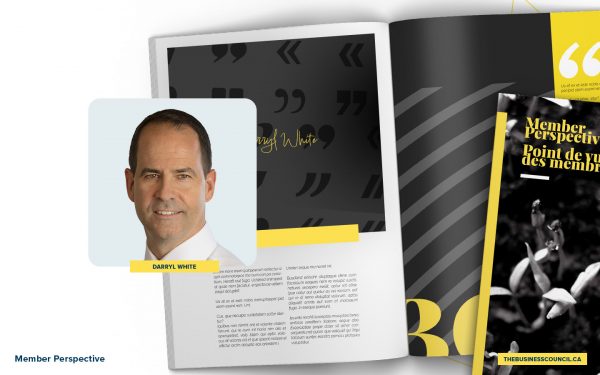A call for urgent and simultaneous action on two fronts
cc The Honourable Chrystia Freeland, Deputy Prime Minister and Minister of Finance
Dear Prime Minister,
When the COVID-19 emergency struck Canada eight months ago, business leaders across the country pledged to do everything in their power to protect their employees, customers and all Canadians. We write to you today in that same spirit, recognizing that nothing matters more to the long-term well-being of Canadians than a safe, healthy and sustainable economic recovery.
Achieving this will require urgent and simultaneous action on two fronts:
- We must redouble our efforts to stop the spread of the virus so individuals and families in every region can confidently resume their normal activities to the greatest extent possible.
- We must seize the opportunity to develop a bold and ambitious strategy for growth and renewal – a plan that creates well-paying jobs, drives investment and unlocks Canada’s productive potential. Leading economies are acting fast to position themselves for success in the post-pandemic world. We must do the same.
In the two months since the federal government last provided an economic update, the number of new confirmed cases of infection across the country has soared. This week, the number of deaths in Canada due to the virus has surpassed 10,000. Despite that, COVID-19 testing capacity in many communities remains woefully inadequate, the wait for test results is unnecessarily long, and contact-tracing efforts range from insufficient to non-existent.
At the same time, Canadians have grown increasingly frustrated by confusing and contradictory public health advice, causing some to lose faith in the system’s ability to protect them. This cannot be left unaddressed.
Early in the pandemic, we called on all levels of government to develop a consistent national approach to dealing with the coronavirus, including a common set of risk-informed protocols and guidelines for schools, workplaces and public settings. We are now well into the second wave and there is still far too little coordination among levels of government and across jurisdictions.
Canadians will be living with COVID-19 well into 2021, if not longer. They and their governments can continue to react day-by-day and in piecemeal fashion to the evolving threat, or we can step back, regroup and resolve to do better. We urge the federal government to take the lead now by launching an independent interim review of Canada’s response to the pandemic, highlighting successes as well as failures and identifying areas where we can learn from the experiences of other countries. The goal should be to deliver recommendations before the end of 2020 so we are better prepared for what lies ahead. We in the business community are ready to support such a review and share our perspective – including our experiences in reopening and operating safely. It is never too late to learn and adjust.
In the coming weeks, your government intends to bring forward an economic and fiscal update, laying out the steps Canada is taking to stabilize the economy and the impact of those measures on the federal debt and deficit. In our view, the economic update must address the following:
The need for a fiscal anchor. Before COVID-19, the government’s fiscal anchor was a declining debt-to-GDP ratio. As the recovery proceeds and the requirement for emergency income support abates, a new fiscal anchor will be needed to ensure that federal finances stay on a sustainable path. Establishing a clear fiscal anchor would impose much-needed discipline over budgetary decisions and help maintain credibility with credit-rating agencies and the public.
Help for distressed sectors. COVID-19 has dealt a devastating blow to Canada’s airlines, hotels, restaurants and tourism operators.The government promised in its Sept. 23 throne speech to bring forward additional support for these industries, but has yet to announce details. Canada is the only member of the Group of Seven leading industrialized countries that has not provided major financial aid for the air transport sector. Countries around the world have acted to protect industries central to their economic competitiveness and Canada must do the same.
A national vaccine distribution plan. Canada’s chief public health officer, Dr. Theresa Tam, has acknowledged that the task of distributing a future COVID-19 vaccine is “bigger and more challenging” than any previous vaccine program. In the likely event that supplies are limited, provincial and territorial health authorities will be responsible for identifying priority groups and determining the order in which people will be offered the vaccine. To avoid a patchwork approach that further contributes to public confusion and mistrust, we urge both levels of government to agree on a clear, consistent and transparent vaccine distribution plan.
As business leaders who care deeply about the country and the communities within which we operate, we recognize that the government’s top economic priority is to do what it takes to keep the virus under control and Canadians safe. That said, all of us have a responsibility now to plan for the post-COVID-19 world, to articulate a vision, and to set out the guideposts by which we will measure success.
We believe Canada has the potential to emerge from this crisis stronger than before. But we are not naïve. The pandemic triggered the most serious economic shock the world has experienced since the Second World War. When it subsides, the global economy is going to look markedly different. International supply chains and trading patterns will be reshaped, competition for jobs and investment will intensify, and the pressure to operate more efficiently will be unrelenting. If we fail to recognize these challenges and take action soon to address them, Canada will fall further behind and our collective well-being will suffer.
Today, we are releasing a report titled, “Powering a Strong Recovery: An Economic Growth Plan for Canada.” It outlines the most pressing challenges as we see them and puts forward a framework and some initial ideas on how Canada could overcome them. In the coming months we will be reaching out to policy experts, partners and other stakeholders, seeking their advice and input as we work to define a path forward with specific and detailed recommendations.
The world is changing rapidly and it is time to adopt a bold new economic vision and strategy for Canada. We need a plan that builds on the country’s strengths, squarely addresses our weaknesses, and reduces the risks from future disruptions. As leaders of companies that play a vital role as engines of innovation and economic opportunity – and as employers of two million Canadians directly and millions of others indirectly – the members of the Business Council of Canada stand ready to work with you and all parliamentarians in building a better future for all Canadians.
Sincerely,

Goldy Hyder
President and CEO
Business Council of Canada











